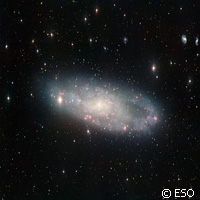New snaps of a not-so-distant neighbour
Images produced at the European Southern Observatory's (ESO) La Silla Observatory in Chile provide a spectacular view of NGC 247, a galaxy in the Cetus constellation. It is a remarkable peek across our galactic garden fence, towards one of the closest spiral galaxies of the southern sky. How far away is NGC 247? Not as far as one might think. A new colour image was produced with the Wide Field Imager on the MPG/ESO 2.2-meter telescope, a piece of equipment on indefinite loan from Germany's Max Planck Gesellschaft (MPG) to the ESO in Chile. The picture was generated from a stack of monochrome exposures taken over many years, combined with exposures through a filter that isolates the glow from hydrogen gas. The resulting view clearly features a range of the galaxy's component stars as well as its spiral arms, dotted with glowing pink clouds of hydrogen indicative of active star formation. And it also shows other galaxies further afar, some of which are peering through NGC 247's dusty disc. NGC 247 is one of a volley of galaxies associated with the Sculptor Galaxy, NGC 253. Together, they form the Sculptor Group. 'This is the nearest group of galaxies to our Local Group, which includes the Milky Way,' says ESO, 'but putting a precise value on such celestial distances is inherently difficult.' Located just over 11 million light years away, NGC 247 has indeed recently been found to be more than 1 million light years closer to the Milky Way than previously thought. Viewed from Earth, it is also highly tilted. This observation may go part of the way to explaining where earlier distance estimates went wrong. 'To measure the distance from the Earth to a nearby galaxy, astronomers have to rely on a type of variable star called a Cepheid to act as a distance marker', explains ESO. 'Cepheids are very luminous stars whose brightness varies at regular intervals. The time taken for the star to brighten and fade can be plugged into a simple mathematical relation that gives its intrinsic brightness. When compared with the measured brightness this gives the distance. However, this method isn't foolproof, as astronomers think this period-luminosity relationship depends on the composition of the Cepheid.' And there are other factors involved. The light of the Cepheids may, for example, be dimmed by dust, making these stars look fainter, and thus farther, than they actually are. This applies more particularly to NGC 247, as the line of sight to the Cepheids passes through its dust disc. An international team of astronomers from institutions in Chile, France, Germany, Italy, Poland and the US is analysing the factors that affect these distance markers. Collaborating in the Araucaria Project, they aim to clearly identify the most accurate stellar methods of distance measurement and to improve the calibration of the local extragalactic distance scale. They have, explains ESO, already reported that earlier distance estimates for NGC 247 were about a million light years out.For more information, please visit:European Southern Observatory (ESO):http://www.eso.org/public/Araucaria Project:https://sites.google.com/site/araucariaproject/
Countries
Chile, Germany, France, Italy, Poland, United States



